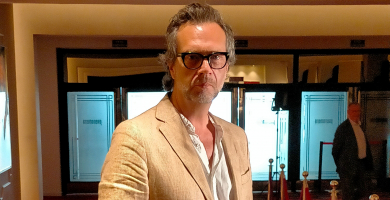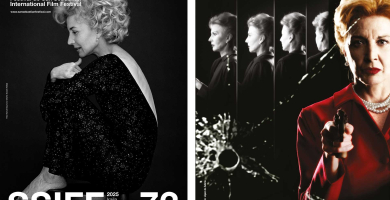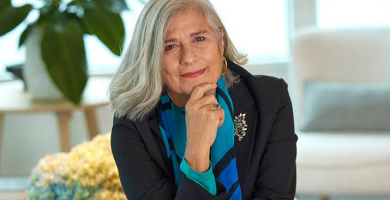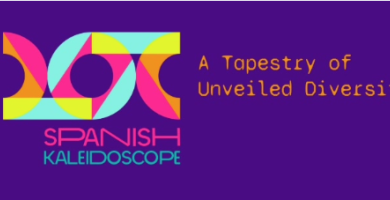
DENIS DELESTRAC: "We could learn to dance together or rather to dance around him. Without getting in his way, without being in the wrong place when something happens and, above all, without trying to reproduce his work.".
This month we interview the director and producer Denis Delestrac, who has directed documentaries such as Freightened The Real Price of Shipping, Sand Wars and Banking Nature. In this interview we talk about his documentary on the famous photographer and storyteller McCurry, The Pursuit of Colour, which he also shot in our city.

Steve McCurry and you met a few years ago and you actually completed your first project as a filmmaker with him. Can you explain how this first meeting arose?
We met in India in 2001 and I made an initial mini-documentary with him. That led to a friendship which we’ve maintained over all those years. We met up from time to time, once in Paris, another time in New York, another in Barcelona. This link never disappeared. Seven years ago I asked myself, as a film director, how one person is capable of saying so much with a single image. Because we shoot a lot, 25 images per second and we have a very broad toolbox for telling stories. But the photographer just has his camera and his eyes. And just with that he’s capable of describing in a single image, in just one frame, the entire suffering or the entire hope of a people. For example, in the case of the refugees and his most famous image. And he has many more images, not just that one. This fascinated me. One morning I phoned Steve and said to him: “Listen, let’s make a film”. And he said: “Yes, okay”. One week later we were shooting in Asia.
Steve McCurry isn’t very fond of talking about himself. Was it difficult to gain the photographer’s trust so that he would open up in this documentary?
He’s a discreet person; some would even say private. Because, like many artists, he lets his work talk for him and he prefers to be behind the camera. We were really lucky in the access we had. He accepted to make this film because there was mutual trust. Many people had tried to make a film about Steve McCurry and he always said no. And he said yes to me.
Luckily, it was a long shoot. Because over these five years of shooting all over the planet, we’ve learnt to respect each other’s space and, above all, to let him work and witness his way of doing things, how he finds an image, or how sometimes an image finds him, appeals to him or calls him. And to see his creative process, which very few people have seen. And to understand that it’s based on empathy, on an interest in telling the story of others. That sometimes it’s a story which is much bigger than just one image or one outlook; it’s a window to the soul, which tells global stories, which tells stories about what we are like as a species, how we relate to each other, our contradictions. This also led to the title: The Pursuit of Colour. In my opinion, colour is a metaphor for diversity. I think it’s a very topical film in so far as this great palette of colours that makes up the human race is an asset. Difference is an asset. And now is a good time to recall that we all form part of the same species, we’re all on a big ship which is turning, which is moving in space and that we have to accept and respect each other, and I think that’s very important.
In your documentaries, you look beyond your environment. The sand on the beach took you to Sand Wars. The clothes you’re wearing and where they are made led to Freightened. In a certain sense it’s similar to what Steve McCurry does with his photos.
Thirty years ago being an ecologist was a decision based on information. Now, I don’t think we have a choice. We’re all ecologists and that’s good news. We’ve all understood that we have to act, on our own scale; we have to be informed and know that this planet’s very small, that we have to look after it in order to look after ourselves and those who come afterwards.
There isn’t another planet to replace it.
Some think there is.
You were shooting for five years, as you mentioned. What was the main difficulty that you encountered on portraying this character?
Apart from the difficulties inherent in shooting a film, like the logistics, the craftsmanship work in itself, the travelling, the shooting, the editing… there really weren’t many. It was more a question of challenges. The challenge of understanding how a lone photographer works. And, above all, leaving him alone and respecting his space for the benefit of the film, so that we could be witnesses of these images which appear. In actual fact, in the film we have very interesting moments when nothing happens. Steve is walking along the street and suddenly stories, images, an outlook appears which tells a story. And it’s basically a question of shooting a lot and shooting when nothing’s happening in case something happens. Sometimes something happens and it’s wonderful. That a camera is capable of being a witness to reality, to the birth of a photograph that can be iconic and to all the stories that exist behind it. And also to be a witness to this approach and the whole connection that he has, which is also the global image of his work, that we’re all connected. He applies this when he goes out in the street with his camera. He goes into what he calls a moment of meditation, in which everything fits in and in which you have the energy of the place or of a person which offers you a perspective when you lift up the camera. It’s wonderful to see this non-verbal connection, almost like Bluetooth between two people, even if it’s just for a fraction of a second. Because there’s a great deal of generosity and respect.
The photographer has to be invisible and you also have to be invisible so as not to interfere with his work. How do you achieve this distance, but at the same time closeness?
Luckily this shoot was long, because we could learn to dance together or rather to dance around him. Without getting in his way, without being in the wrong place when something happens and, above all, without trying to reproduce his work. He searches for images which tell a story and I want to tell his story. We don’t use the same codes as regards light or colour. After so long travelling together to so many places we created a sort of family. We don’t need to talk because we can understand at what moment the other person is. And we know how to aim the camera where it should be. And that’s a very interesting shooting style.
Has Steve McCurry’s style of taking photographs helped or changed you in any way as a filmmaker?
Not his style of taking photographs, but his discipline. That changed the whole team. He’s someone who, after a long 15-hour day of shooting, is capable of continuing to take photos. You’re tired, you want to go to the hotel, have a shower and relax. But he doesn’t stop. His batteries never wear out. And we learnt that from him. Punctuality, discipline. The great secret of these stories he tells which can reach so many people is hard work. There’s also something that he repeats a lot, which is that life is short. It’s like a mantra. I think we were all imbued with this idea that, if we want to do something, we have to do it now and the present time is the most important, because we don’t know what will happen tomorrow.
Steve McCurry is renowned worldwide for the photo of the Afghan girl, but you didn’t focus on that, which always stands out from his work. What was the guiding thread on editing the documentary?
With time the shadows of iconic images tend to get longer and to eclipse the whole work. And I wasn’t interested in making a documentary about the Afghan girl. This is precisely the anti-Afghan girl documentary; it’s a documentary about the creator of images, the storyteller. And I think this documentary is very important, especially now, because Steve has an admirable life; he has a very interesting outlook which gives us a privileged window to understand what we’re like as a species, and you can’t restrict that to a single image.
When it comes to editing a documentary like this, what difficulties did you confront?
You write the documentary before shooting, during and when you finish shooting, then you look again at everything you have. In this case there were 400 hours of material shot over five years on all continents. You sit down, you view it and the story gradually emerges, you gradually write and edit it. And, obviously, the first version is unbearable (laughs). You keep editing versions until the day you press play and the story touches your soul, it strikes a chord and moves you. And, above all, when the story reflects the true picture. Obviously it’s subjective, because objectivity doesn’t exist, above all in a creative documentary, because it’s seen through the eyes of a director, a director of photography, an editor, etc. but I think it reflects the character, his life and the value of his work.
You shot part of the documentary in Barcelona, didn’t you?
We began to shoot in Asia, and just after that in Barcelona we shot a series of interviews with Steve, which are the film’s central axis. It’s a city that Steve loves.
You’ve lived here in Barcelona for many years. What has the city given you?
It’s given me a house, a family and a place where I feel at home. After having travelled and lived in several countries, I’ve lived here for 24 years and my home is here. When people ask me if I’m French, I say that my origin is French (laughs), because I’m from here now, I’ve embraced the city, the light, but also the people, its culture, its history, I respect and love it.









